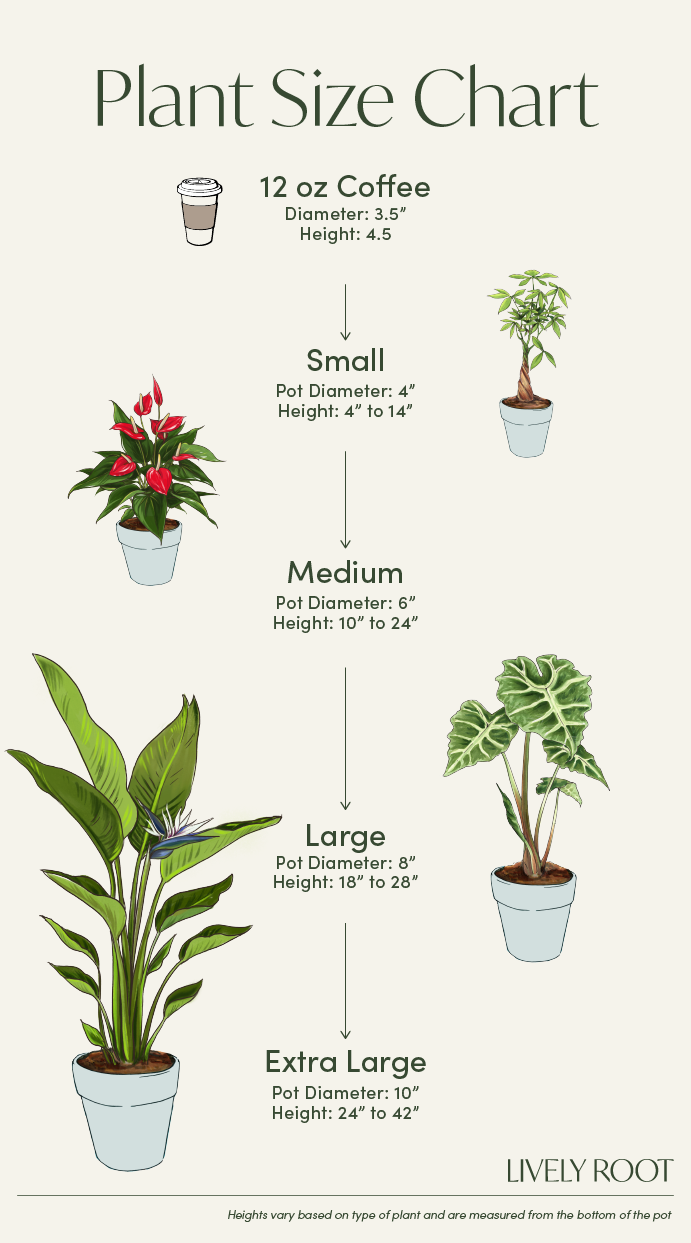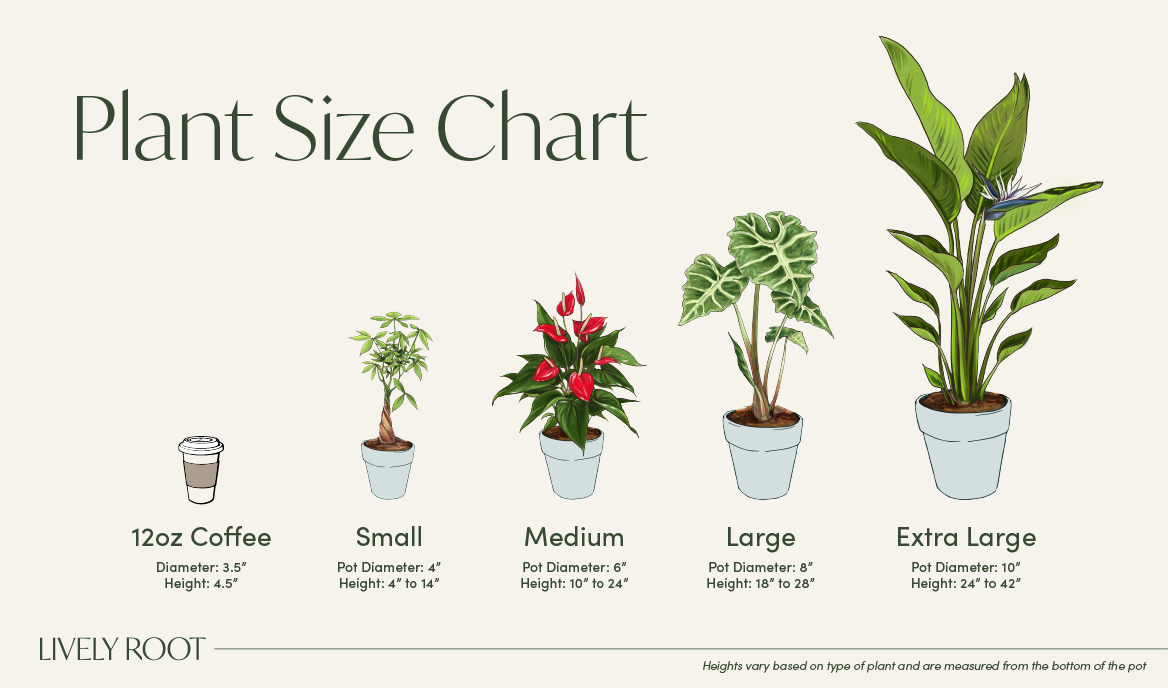

Observe the Bird's Nest Fern (Asplenium Nidus AGM) fronds as they remind us of a ruffled skirt. This epiphytic tropical, with their lush, leathery leaves, makes a stunning centerpiece. When the new fronds emerge, they resemble bird eggs, hence, their name. At maturity, these will reach 4 feet in length in the right conditions.
Bird's Nest Fern Care Guide & Presentation

Give this plant bright, indirect light in a southern-facing window or a combination of exposures. The brighter the light, the more increased waviness of the leaves.
Use filtered, bottled, or tap water sitting 24 hours to release the chemicals and water enough that the water discharges out of the drainage holes. Once the water is fully drained, replace them into the cache or decorative pot. Don't let the roots sit in standing water. Keep the soil consistently moist and well-drained. When watering, avoid the frond rosette to prevent rotting. Keep the leaves dry to avoid fungal and bacterial infections.
Enjoys medium to high humidity. Add a pebble tray or humidifier to keep the humidity around them high but don't spritz the leaves as that can cause fungal and bacterial infections. Keep the leaves dry.
This plant likes warmer temperatures. Keep it out of cold drafts.
Outside: Keep them in shade on a patio out of direct sunlight to prevent leaf burn where nights are above 65°F.
Fertilize every two weeks during the growing season (spring and summer) by diluting a liquid fertilizer by half strength. Let the plant rest in the fall and winter. Note: If the leaves lose the wavy edges, your plant may be getting too much fertilizer. If so, fertilize once a month.
When receiving the plant, do not repot immediately but wait at least 6-12 months or if the roots are beginning to get crowded and growing through the drainage holes.
Repot in the spring, using a 2" bigger pot to keep the roots drier. Use a well-draining indoor potting mix with perlite with an equal mix of charcoal to help with drainage and hold plant nutrients.
Water your plant in the old pot before transferring over and let them sit an hour. Place a piece of screening at the bottom of the container over the drainage hole to the soil and allow it to drain. Add soil to the bottom to elevate the root ball. Lift the plant and release the roots against the existing planter. Use a clean knife or garden trowel to wedge between the pot and the soil to loosen.
Inspect the root ball. Notice if there are any dead or rotting roots and trim off with sterile pruners. If the plant is rootbound, cut through the roots to alleviate continued encircling.
Ensure the plant is sitting about 1" below the edge of the pot to avoid water spillage. Add more soil and backfill around the sides by tamping down. Fill up to the soil line but not over.
Water thoroughly, leaving the soil damp but not soggy. If settling occurs, add more soil.
Misting the leaves daily will keep the leaves on this plant clean. Remove any debris from the soil surface and replenish if needed. Trimi any damaged or browning tips and avoid letting water or debris fall into the rosette.
Birds nest fern is very tough to propagate for the average gardener.
If you adventurous and a bit curious, try reproducing your own bird's nest fern by harvesting its spores. The spores are the small rows of brownish, fuzzy spots along the bottom of the leaves. When these spores look fat and fuzzy, trim off the leaf they're on by cutting it down to the bottom of the stem. Delicately set them into a paper plate. Over the next few days, the spores should fall onto the paper plate as they dry.
Afterward, gather several containers of sphagnum moss. Spread the spores over the top surface, and keep them uncovered. Put your pots of moss and spores in a dish of water to bottom soak through the moss. Cover the pot with a clear plastic bag to create a mini "greenhouse" to keep humidity high, or hand-mist the top daily. Keep the temperatures between 70-80 degrees in bright, indirect light.
Germination starts in approximately 2-3 weeks if the humidity is kept high. Once the sprouts have grown, remove the plastic cover. Provide high humidity around the leaves as they grow by using a pebble tray and humidifier.
Bird's Nest Fern: Overview
Get the gorgeous Bird's Nest Fern (Asplenium nidus) and enjoy it as a stunning centerpiece in your living room! This bushy plant boasts a lush rosette of green, leathery, and wavy fronds. The Bird’s Nest Fern is an epiphyte, like Bromeliads or Orchids, attaching itself to other plants when it grows in the wild.
The Bird’s Nest Fern belongs to the Aspleniaceae family and is native to the tropical areas of Southeast Asia, Africa, Polynesia, and Australia. This beautiful fern can grow outdoors on the patio in hardiness zones 10-11, preferably in partial shade. When mature, the long, stemless fronds of the Bird’s Nest Fern plant can reach up to 4 ft. in length. Indoors, this gorgeous fern often lives for over 15 years and grows gradually thicker and larger. This tropical plant needs plenty of bright, indirect sunshine and humidity but is otherwise easy to care for, even for beginners. Moreover, this plant is non-toxic and pet-friendly.
In Feng Shui, the fern bird’s Nest symbolizes growth, tenacity, and adaptability to change. Ferns are often recommended for balancing the energy in interior spaces and creating a sense of tranquility and rest.
Bird's Nest Fern: Benefits
- Purifies the air, removing toxins like formaldehyde
- Lush, beautiful foliage with a tropical vibe
- Symbolizes growth and resilience in Feng Shui
- It’s a low-maintenance plant
- Increases humidity and lowers the temperature
Bird's Nest Fern: Care Guide
The Bird’s Nest Fern is easy-care and adaptable. Here is how to care for Bird's Nest Fern to keep it in perfect shape:
Watering and Humidity
Bird’s Nest Ferns prefer consistently moist but not soggy soil. Water your plant regularly, but let the water drain before replacing it in its decorative pot. The Bird’s Nest Fern thrives in medium to high humidity. You can increase humidity around this indoor plant by placing it on a pebble tray or grouping it with other plants. To avoid fungal and bacterial diseases, refrain from misting the leaves.
Light and Temperature
This fern grows best in bright, indirect light but can adapt to lower light levels. Never leave your Bird’s Nest Fern in direct sunlight to avoid leaf burn. Providing your plant with sufficient light is vital to keep its fronds wavy.
The best temperatures for this tropical fern range from 70°F to 80°F. If grown as a porch plant, bring it indoors when the night temperatures fall below 65°F.
Soil, Feeding, and Repotting
This beautiful plant grows best in well-draining, nutrient-rich soil. Mix in some perlite and charcoal to enhance drainage and provide the necessary nutrients. Feed your plant weekly with a liquid fertilizer during the growing season.
Repot in spring or when the roots start growing out of the drainage holes, as this plant won’t require repotting immediately after purchase. Water the fern well before repotting.
Propagation
You can propagate a large Bird’s Nest Fern plant by dividing it carefully during repotting. Plant the individual sections in pots of soil and place them in a location with bright, indirect light.
If you’re an experienced indoor gardener, you can try to propagate your fern from spores. These are brownish fuzzy spots located along the underside of the fronds.
Pruning, Cleaning, and Common Issues
A key aspect of Bird's Nest Fern care is knowing when and how to trim it. Prune it in the spring or the beginning of summer so the plant can grow new foliage in the active season.
To remove dust, clean your fern’s leaves with a damp cloth. Keep the soil free from debris and dead leaves.
If your fern isn’t getting enough light, its leaves may start yellowing. Dry weather can cause brown leaf tips, so increase the humidity around your plant. If your Bird’s Nest Fern fronds are getting less wavy, this may be due to insufficient light or too much fertilizer.
Bird's Nest Fern: Placement, Companion & Alternative Plants
Let’s see the best placement options for your Bird’s Nest Fern and some companion and alternative plants.
Best Locations & Uses
- Amazing, pet-friendly choice for pet owners
- Perfect gift plant for beginner indoor gardeners
- Wonderful, compact fern for your office
- Ideal bedroom plant because of its air-cleansing properties
- Great as a porch plant in warm, humid climates
Companion Plants
Keep humidity high around your plant by grouping it with other moisture-loving plants:
- Maranta Red Prayer Plant (Maranta leuconeura var. kerchoveana): The Maranta Red Prayer Plant thrives in humid environments, making it a perfect companion for your beloved fern.
- Dwarf Cavendish Banana Tree (Musa acuminata): A plant with large, broad leaves, the Dwarf Cavendish Banana Tree produces edible bananas you can grow at home.
- Pink Flamingo Flower (Anthurium andraeanum Pink): With its flowers resembling pink hearts, the Pink Flamingo Flower is a delightful humidity-loving plant to add to your collection.
Alternative Plants
Ferns are adaptable and beautiful plants with a tropical and vibrant ambiance, and there are plenty of alternative varieties to choose from and find the perfect fit for your home:
- Black Rabbit Foot Fern (Davallia fejeensis): An epiphyte with lacey leaves, the Black Rabbit Foot Fern has fuzzy rhizomes at the base that resemble a rabbit’s hind feet when small.
- Staghorn Fern (Platycerium bifurcatum): With its large antler-like fronds, the Staghorn Fern is an unusual and eye-catching plant.
- Lemon Button Fern (Nephrolepis cordifolia 'Lemon Buttons'): An adorable fern with airy leaves, the Lemon Button Fern is easy-care and compact.
Green Up Your Space With a Bird's Nest Fern From LivelyRoot!
Order the lush and beautiful Bird's Nest Fern from Lively Root and transform your indoor or outdoor space!




















